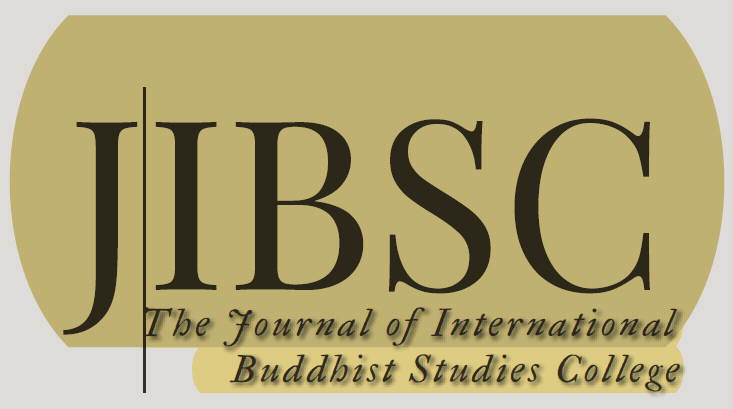The Promotion of Sympathetic Joy (Muditā) in Buddhist Psychology of PhD Students at International Studies College (IBSC), Mahachulalongkornrajavidyalaya University (MCU)
Main Article Content
Abstract
This study explores the promotion of sympathetic joy (muditā) in Buddhist psychology, focusing on PhD students in the Buddhist Studies program at the International Buddhist Studies College (IBSC), Mahachulalongkornrajavidyalaya University (MCU). The research objectives are threefold: (1) to analyze muditā meditation in Theravāda Buddhism and modern psychology as effective methods for its cultivation; (2) to investigate the practice of muditā among PhD Buddhist Studies students at IBSC, MCU; and (3) to propose a structured framework for fostering muditā within Buddhist psychology. Employing a mixed-methods approach, the research integrates textual analysis of Theravāda scriptures (e.g., Visuddhimagga, Dīgha Nikāya) and contemporary psychological literature, alongside semi-structured interviews with 15 PhD students and 9 meditation masters.
The findings indicate that the cultivation of muditā unfolds through four progressive levels. The first stage emphasizes sammā saṅkappa (right intention) to establish benevolence as a foundational mindset. The second stage cultivates 19 sobhana cetasikas (wholesome mental factors), such as mindfulness (sati), equanimity (upekkhā), and mental pliancy (kāya-passaddhi), aligning with the Sun and Moon Theory’s premise that positive states displace negative emotions like envy (issā). The third stage, termed “Maturement,” integrates ethical discipline (sīla) through right speech, action, and livelihood, ensuring moral stability as a prerequisite for sustained practice. The final stage enables practitioners to embody impartial muditā, rejoicing in others’ successes without bias, even toward adversaries. Findings reveal that successful muditā practice correlates with self-reported reductions in jealousy and enhanced emotional resilience, validated through participants’ reflective journals. Longitudinal benefits include advanced meditative absorption (jhāna), potential rebirth in the Brahmā realm, and progression toward the anāgāmi (non-returner) stage of enlightenment. This framework bridges classical Buddhist ethics with modern psychological paradigms, offering a structured pathway to nurture muditā as both a spiritual virtue and a tool for mental well-being in academic contexts. This research contributes significantly to the understanding and promotion of muditā, a valuable virtue for enhancing mental well-being and social relationships.
Article Details
The Journal of TCI is licensed under a Creative Commons Attribution-NonCommercial-NoDerivatives 4.0 International (CC BY-NC-ND 4.0) licence unless otherwise stated. Please read our Policies page for more information on Open Access, copyright and permissions.
References
Barcaccia, B., Baiocco, R., Pozza, A., Pallini, S., Mancini, F., & Salvati, M. (2019). The more you judge, the worse you feel: A judgmental attitude towards one’s inner experience predicts depression and anxiety. Personality and Individual Differences, 138, 33–39. https://doi.org/10. 1016/j.paid.2018.09.012
Bhikkhu Bodhi. (1993). A comprehensive manual of Abhidhamma. Buddhist Publication Society.
Bhikkhuni Do Le Anh Thi, Phramaha Hansa Dhammahaso & Phramaha Nantakorn Piyabhani. (2022). The Effective Way of Cultivating the Mind Based on Wise Attention (Yoniso-manasikāra). Journal of International Buddhist Studies, 13(1), 60-74.
Chalmers, R. (1977). The Majjhima-Nikāya (Vol. III). Pali Text Society.
Daw Mya Tin. (1986). The Dhammapada: Verses and stories. Burma Tipitaka Association.
Dhammananda, K. S. (2012). How to live without fear and worry? Hwa Dzan Society Publication.
Doty, J. R. (2012). A pilot study on the psychological and physiological effects of compassion through the Compassion Cultivation Training (CCT) Program [Research study, Stanford University].
Feer, M. L. (1989). Saṃyutta-Nikāya, Nidāna-Vagga (Part II). Pali Text Society.
Hardy, E. (1961). The Aṅguttara-Nikāya (Part III, Pañcaka-nipāta and Chakka-nipāta, 2nd ed.). Pali Text Society.
Mahatthanadull, S. (2019). Theravāda Buddhist practice and the access of happiness. Mahachulalongkornrajavidyalaya University Publications.
Mirchandaney, R., Barete, R., & Asarnow, L. D. (2022). Moderators of cognitive behavioral treatment for insomnia on depression and anxiety outcomes. Current psychiatry reports, 24(2), 121-128. https://doi.org/10.1007/ s11920-022-01326-3
Morris, R. (1976). The Aṅguttara-Nikāya (Part II, Catukka Nipāta). Pali Text Society.
Muller, E. (1979). Atthasālinī: Buddhaghosa’s commentary. Pali Text Society.
Narada Maha Thera. (1979). A manual of Abhidhamma (Abhidhammattha Sangaha). Buddhist Missionary Society.
National Institute of Mental Health. (2024, October 10). Autism spectrum disorder. U.S. Department of Health and Human Services, National Institutes of Health. https://www.nimh.nih.gov/health/topics/autism-spectrum-disorders-asd
Neff, K. D. (2022). The differential effects fallacy in the study of self-compassion: Misunderstanding the nature of bipolar continuums. Mindfulness, 13, 572–576. https://doi.org/10.1007/s12671-022-01832-8
Rhys Davids, C. A. F. (1975). Visuddhi-Magga of Buddhaghosa. Pali Text Society.
Rhys Davids, C. A. F. (1978). The Vibhaṅga: The second book of the Abhidhamma Piṭaka. Pali Text Society.
Rhys Davids, T. W., & Carpenter, J. E. (1966). The Dīgha Nikāya (Vol. II). Pali Text Society.
Rhys Davids, T. W., & Stede, W. (1925). Pali-English dictionary. Pali Text Society.
Seppälä, E. M. (2017). Oxford handbook of compassion science. Oxford University Press.
Taylor, A. C. (1979). Kathāvatthu (Vol. II). Pali Text Society.
Wattanaseth, T. (2016). A study of meditation effect on the brain and emotional happiness by MiRi Scan. The Journal of the International Association of Buddhist Universities (JIABU), 11(2), 179–194.

